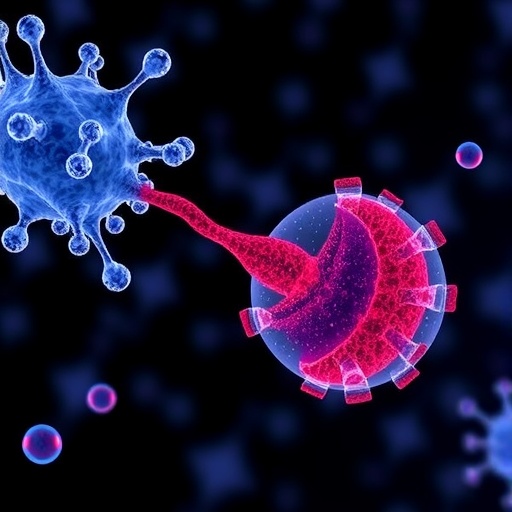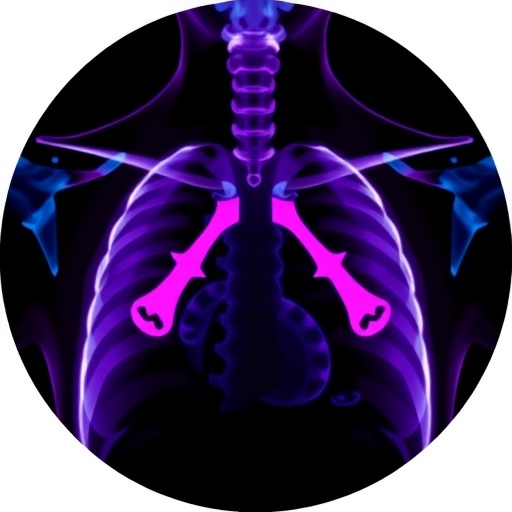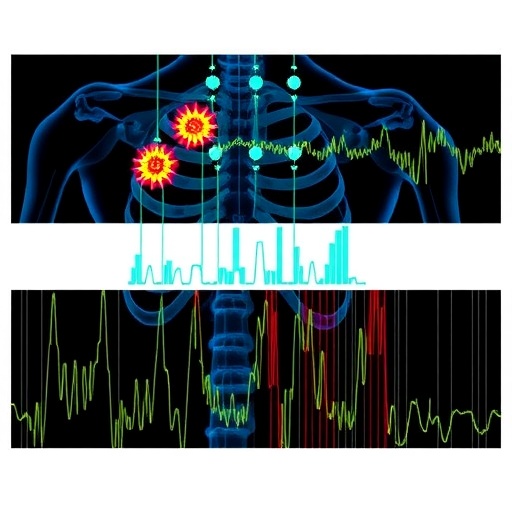
In a groundbreaking study poised to revolutionize the early diagnosis of esophageal squamous cell carcinoma (ESCC), researchers have unveiled a novel non-invasive method leveraging the proteomic and lipidomic profiles of saliva-derived exosomes. ESCC, a highly aggressive malignancy with notoriously poor prognosis if detected late, traditionally demands invasive and uncomfortable endoscopic biopsies for diagnosis. This innovative approach, highlighted in a recent publication in BMC Cancer, holds the potential to shift the diagnostic paradigm by offering a sensitive, precise, and patient-friendly option.
Esophageal squamous cell carcinoma is among the most prevalent forms of esophageal cancer worldwide, characterized by its rapid progression and limited treatment success when detected at advanced stages. Early diagnosis is pivotal to improving survival rates. However, current clinical practice relies heavily on endoscopic biopsy, an invasive technique that requires specialized facilities and carries associated risks and patient discomfort. Consequently, there has been an urgent clinical and scientific demand to identify easily accessible biomarkers conducive to early, reliable detection.
The study, conducted by Zhong et al., focuses on saliva, a biofluid that has increasingly garnered attention for its rich molecular content and accessibility. In particular, exosomes—nano-sized vesicles secreted into saliva—serve as carriers of various biomolecules, including proteins and lipids, reflecting physiological and pathological states of the body. Despite the emerging appreciation of salivary exosomes in diagnostics, comprehensive profiling of their proteomic and lipidomic landscapes in ESCC had remained unexplored until now.
.adsslot_P1Hgj6Jeq8{width:728px !important;height:90px !important;}
@media(max-width:1199px){ .adsslot_P1Hgj6Jeq8{width:468px !important;height:60px !important;}
}
@media(max-width:767px){ .adsslot_P1Hgj6Jeq8{width:320px !important;height:50px !important;}
}
ADVERTISEMENT
Employing ultracentrifugation techniques, the researchers isolated exosomes from the saliva of 54 individuals diagnosed with ESCC and 62 healthy controls. They then subjected these exosomes to an advanced, untargeted liquid chromatography-tandem mass spectrometry (LC–MS/MS) analysis to simultaneously map their proteomic and lipidomic compositions. This dual-omics approach allowed the team to capture intricate molecular differences that could differentiate disease presence with high accuracy.
The analysis revealed striking disparities in both protein and lipid profiles between ESCC patients and healthy individuals. Notably, the proteomic alterations in the exosomal content underscored dysregulation in immune response pathways, disturbances in tissue structural integrity, and increased antifungal and antimicrobial humoral activities. These findings suggest that ESCC induces profound changes in the oral immune microenvironment, perhaps reflecting tumor-driven modulation of host defenses.
Lipidomic data provided compelling insights into metabolic shifts associated with ESCC. The study found evidence implicating fatty acid metabolism as a key axis altered during the disease state. Intriguingly, the researchers propose that ESCC may influence this metabolic pathway through epigenetic modifications, thereby indirectly reshaping the oral immune milieu. This crosstalk between metabolism and immune function highlights a complex interplay that might drive tumor progression and immune evasion.
An integrated multi-omics correlation analysis further strengthened the causal narrative between proteomic dysfunction and lipidomic remodeling in ESCC’s pathobiology. This comprehensive viewpoint underscores the sophistication of tumor-induced systemic alterations and opens avenues for mechanistic exploration. More importantly, such multi-dimensional data provide a rich repository from which robust diagnostic markers can emerge.
Capitalizing on these molecular disparities, the research team constructed a diagnostic model based solely on 28 distinct lipid features identified within salivary exosomes. This lipid-based signature demonstrated an astounding diagnostic performance, achieving an Area Under the Curve (AUC) of 1.000, indicative of perfect discrimination between ESCC patients and healthy controls. This level of sensitivity and specificity, if replicated in larger cohorts, could redefine screening and monitoring protocols for esophageal cancer.
The implications of this study are far-reaching. The utilization of saliva-derived exosomes as a diagnostic medium offers a non-invasive, easily accessible, and patient-compliant alternative that avoids the logistical challenges and discomfort associated with endoscopic biopsies. Furthermore, the robustness of the lipidomic signature advances the field’s understanding of tumor metabolism and systemic influence beyond traditional tissue-based biomarkers.
While the study eloquently demonstrates the promise of salivary exosomes, the authors acknowledge that validation in larger, diverse populations is necessary to corroborate these preliminary findings. Expanding sample sizes, including patients at various disease stages, and assessing longitudinal changes will be critical to establishing clinical utility and reliability.
The technical sophistication underpinning this research, particularly the coupling of LC–MS/MS with integrative multi-omics analyses, exemplifies the powerful convergence of analytical chemistry and molecular biology in contemporary cancer diagnostics. This study serves as a testament to the potential of these technologies to unravel complex disease signatures embedded in accessible biofluids.
Moreover, the work opens new research corridors into how metabolic and epigenetic pathways interface to reshape local immune environments in cancer. Unraveling these mechanisms may not only produce diagnostic tools but could also unveil novel therapeutic targets to counter tumor-induced immune dysregulation.
This pioneering research aligns with a growing trend towards liquid biopsy approaches that capitalize on minimally invasive sample collection. Compared to blood-based assays, saliva offers additional practical advantages, including ease of collection without specialized skills or equipment, which may facilitate widespread screening programs and improve patient adherence.
In conclusion, the integrative proteomic and lipidomic profiling of saliva-derived exosomes heralds a transformative approach for early ESCC diagnosis. By capturing molecular fingerprints reflective of tumor biology and microenvironmental remodeling, this method could dramatically reduce the burden of invasive procedures, enable timely interventions, and ultimately improve patient outcomes. As research advances, translating such findings into clinical settings promises to reshape oncological diagnostics and personalized medicine strategies.
This study’s findings inject optimism into the fight against esophageal cancer and illustrate the power of molecular analytics in uncovering actionable biomarkers. As scientists and clinicians collaborate to validate and implement these methods, patients stand to gain from earlier detection, less invasive procedures, and enhanced survival prospects. The future of cancer diagnostics shines brightly with the promise that saliva—once overlooked—might become the frontline biofluid for disease detection.
Subject of Research: Early non-invasive diagnosis of esophageal squamous cell carcinoma using integrative proteomic and lipidomic analysis of saliva-derived exosomes.
Article Title: Integrative analysis of saliva-derived exosomal proteome and lipidome for the diagnosis of esophageal squamous cell carcinoma.
Article References:
Zhong, W., Liu, J., Xie, J. et al. Integrative analysis of saliva-derived exosomal proteome and lipidome for the diagnosis of esophageal squamous cell carcinoma. BMC Cancer 25, 1254 (2025). https://doi.org/10.1186/s12885-025-14452-x
Image Credits: Scienmag.com
DOI: https://doi.org/10.1186/s12885-025-14452-x
Tags: advancements in cancer diagnosticsbiomarkers for cancer diagnosisearly diagnosis of esophageal canceresophageal squamous cell carcinoma researchexosomes as cancer biomarkersinnovative cancer research methodslipidomic profiles in cancerlipids in salivanon-invasive cancer detection methodspatient-friendly diagnostic techniquesproteomic analysis of salivasaliva exosome proteins





